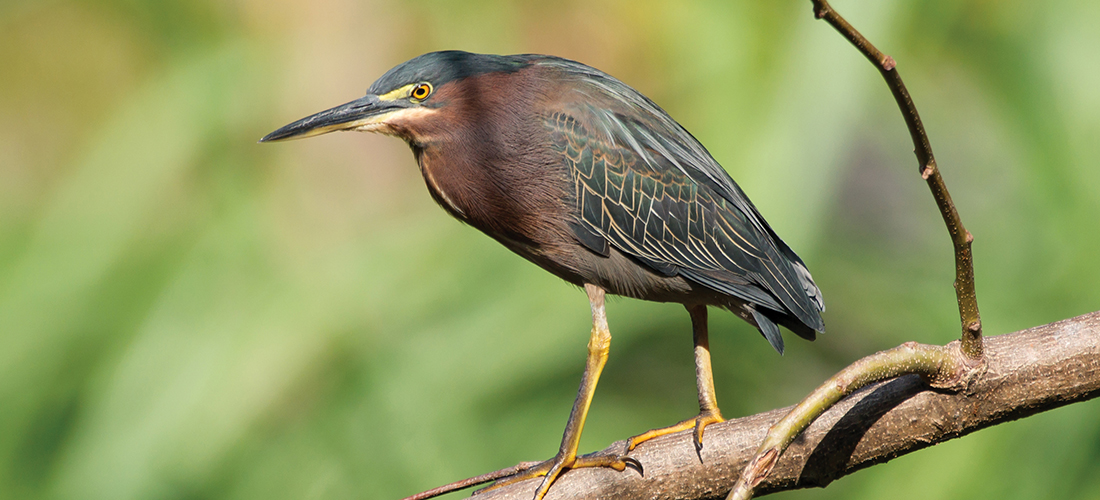
The stealthy green heron returns to N.C.’s waterways
By Susan Campbell
The green heron is probably one of the coolest little birds around — but one that I’d bet most folks have never seen. They return from tropical wintering grounds to breed across the state in early spring, migrating under the cover of darkness back to where they first hatched, beginning the cycle anew. Right now flocks are moving northward in order to pair up for the breeding season. Although they are widely distributed, the green heron’s cryptic coloration and skulking behavior make them tricky to spot.
Standing a mere 18 inches tall and only about the size of a crow, this species is by far the smallest of about a dozen types of waders found in North Carolina. As with all herons, these birds have relatively long legs and a skinny neck, as well as a long, dagger-like bill. Given that green herons typically stand with their necks tucked in, individually they may seem smaller than they are. Their backs are a velvety green (hence the name), their bodies a handsome chestnut and their legs a pale yellow. The feathers on the head, in addition to the wings, are dark gray and often stand erect, giving the appearance of a shaggy crest. As with other herons and egrets, males are identical to females.
During the spring, males seek out thick shrubbery along the edge of a wet spot and begin building a platform of thin sticks as a nest. After attracting a mate, the male looses interest in nest-building, and it is the female that completes the shallow nest. Although the location may very well be along a creek or pond, it may also be man-made, for instance around a smaller depression adjacent to a water hazard on a golf course. Probably more important is whether or not there’s sufficient access to food and woody vegetation to support three to five chicks. Although other wading bird species generally nest in colonies, green heron pairs usually keep to themselves. But they, especially the males, are fiercely territorial when it comes to defending their feeding area. They will vocalize loudly and chase any bird that is perceived as a threat.
Green herons spend most of their time crouched completely still, alongside a wet spot, waiting for prey to appear. They will grab any moving creature that is small enough to swallow. Fish, frogs, crayfish, larger insects and even the odd hummingbird make up their diet. Occasionally, they may spear their food, but most often they grab what they catch with their powerful mandibles. And while green herons are very successful ambush-style predators, they sometimes show a cunning side, using objects such as sticks and insects very deliberately to lure fish to the surface. Surprisingly, they may also occasionally dive after prey. With partial webbing between their toes, they can swim short distances, if need be.
A few green herons lurk in the very southeastern part of our state each winter but most head to Mexico or Central America where food is more plentiful during the colder months. Our birds pass through Florida and head for the Caribbean on their way to marshlands in Central America. There will be plenty of time in the coming months to spot one of these fascinating water birds. So the next time you’re passing a nearby farm pond or overgrown stream bank, carefully scan the banks and low branches — you may just catch sight of this neat little heron! PS
Susan would love to receive your wildlife sightings and photos at susan@ncaves.com.





